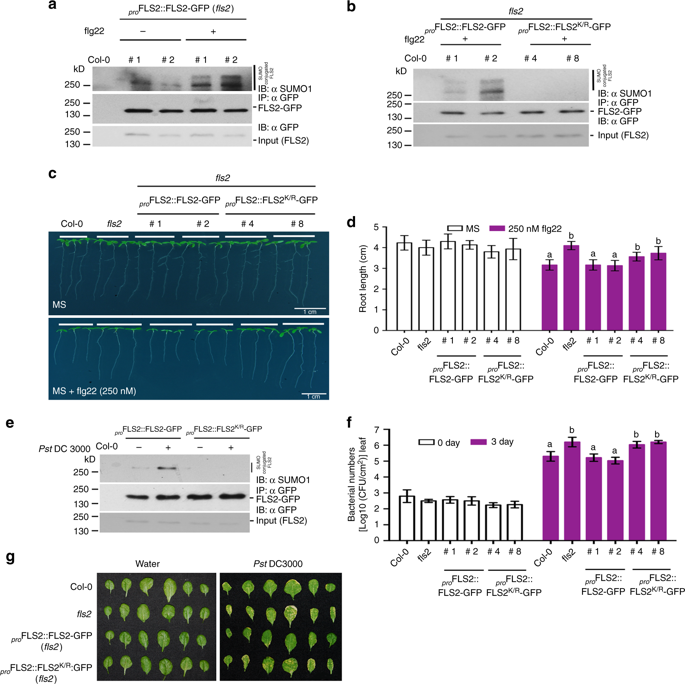当前位置:
X-MOL 学术
›
Nat. Commun.
›
论文详情
Our official English website, www.x-mol.net, welcomes your
feedback! (Note: you will need to create a separate account there.)
SUMO conjugation to the pattern recognition receptor FLS2 triggers intracellular signalling in plant innate immunity.
Nature Communications ( IF 14.7 ) Pub Date : 2018-12-05 , DOI: 10.1038/s41467-018-07696-8 Beatriz Orosa , Gary Yates , Vivek Verma , Anjil K. Srivastava , Moumita Srivastava , Alberto Campanaro , Daniel De Vega , Alanna Fernandes , Cunjin Zhang , Jack Lee , Malcolm J. Bennett , Ari Sadanandom
Nature Communications ( IF 14.7 ) Pub Date : 2018-12-05 , DOI: 10.1038/s41467-018-07696-8 Beatriz Orosa , Gary Yates , Vivek Verma , Anjil K. Srivastava , Moumita Srivastava , Alberto Campanaro , Daniel De Vega , Alanna Fernandes , Cunjin Zhang , Jack Lee , Malcolm J. Bennett , Ari Sadanandom

|
Detection of conserved microbial patterns by host cell surface pattern recognition receptors (PRRs) activates innate immunity. The FLAGELLIN-SENSITIVE 2 (FLS2) receptor perceives bacterial flagellin and recruits another PRR, BAK1 and the cytoplasmic-kinase BIK1 to form an active co-receptor complex that initiates antibacterial immunity in Arabidopsis. Molecular mechanisms that transmit flagellin perception from the plasma-membrane FLS2-associated receptor complex to intracellular events are less well understood. Here, we show that flagellin induces the conjugation of the SMALL UBIQUITIN-LIKE MODIFIER (SUMO) protein to FLS2 to trigger release of BIK1. Disruption of FLS2 SUMOylation can abolish immune responses, resulting in susceptibility to bacterial pathogens in Arabidopsis. We also identify the molecular machinery that regulates FLS2 SUMOylation and demonstrate a role for the deSUMOylating enzyme, Desi3a in innate immunity. Flagellin induces the degradation of Desi3a and enhances FLS2 SUMOylation to promote BIK1 dissociation and trigger intracellular immune signalling.
中文翻译:

SUMO与模式识别受体FLS2的结合触发了植物固有免疫力的细胞内信号传导。
通过宿主细胞表面模式识别受体(PRR)检测保守的微生物模式可激活先天免疫。FLAGELLIN敏感2(FLS2)受体感知细菌鞭毛蛋白并募集另一种PRR,BAK1和胞质激酶BIK1形成活性的共受体复合物,从而启动拟南芥中的抗菌免疫。将鞭毛蛋白感知信号从质膜FLS2相关受体复合物传递到细胞内事件的分子机制了解得很少。在这里,我们表明鞭毛蛋白诱导小泛素样修饰剂(SUMO)蛋白与FLS2结合以触发BIK1的释放。FLS2 SUMOylation的破坏可以消除免疫反应,从而导致拟南芥对细菌性病原体的易感性。我们还确定了调节FLS2 SUMOylation的分子机制,并证明了deSUMOylating酶Desi3a在先天免疫中的作用。鞭毛蛋白诱导Desi3a降解并增强FLS2 SUMOylation从而促进BIK1分解并触发细胞内免疫信号。
更新日期:2018-12-05
中文翻译:

SUMO与模式识别受体FLS2的结合触发了植物固有免疫力的细胞内信号传导。
通过宿主细胞表面模式识别受体(PRR)检测保守的微生物模式可激活先天免疫。FLAGELLIN敏感2(FLS2)受体感知细菌鞭毛蛋白并募集另一种PRR,BAK1和胞质激酶BIK1形成活性的共受体复合物,从而启动拟南芥中的抗菌免疫。将鞭毛蛋白感知信号从质膜FLS2相关受体复合物传递到细胞内事件的分子机制了解得很少。在这里,我们表明鞭毛蛋白诱导小泛素样修饰剂(SUMO)蛋白与FLS2结合以触发BIK1的释放。FLS2 SUMOylation的破坏可以消除免疫反应,从而导致拟南芥对细菌性病原体的易感性。我们还确定了调节FLS2 SUMOylation的分子机制,并证明了deSUMOylating酶Desi3a在先天免疫中的作用。鞭毛蛋白诱导Desi3a降解并增强FLS2 SUMOylation从而促进BIK1分解并触发细胞内免疫信号。































 京公网安备 11010802027423号
京公网安备 11010802027423号